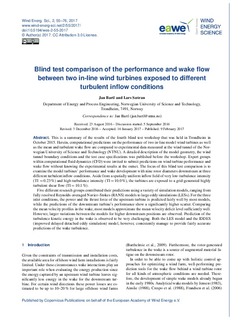| dc.contributor.author | Bartl, Jan Michael Simon | |
| dc.contributor.author | Sætran, Lars Roar | |
| dc.date.accessioned | 2017-03-17T11:49:52Z | |
| dc.date.available | 2017-03-17T11:49:52Z | |
| dc.date.created | 2017-03-10T19:11:22Z | |
| dc.date.issued | 2017 | |
| dc.identifier.citation | Wind Energy Science. 2017, 2 55-76. | nb_NO |
| dc.identifier.issn | 2366-7443 | |
| dc.identifier.uri | http://hdl.handle.net/11250/2434522 | |
| dc.description.abstract | This is a summary of the results of the fourth blind test workshop that was held in Trondheim in October 2015. Herein, computational predictions on the performance of two in-line model wind turbines as well as the mean and turbulent wake flow are compared to experimental data measured at the wind tunnel of the Norwegian University of Science and Technology (NTNU). A detailed description of the model geometry, the wind tunnel boundary conditions and the test case specifications was published before the workshop. Expert groups within computational fluid dynamics (CFD) were invited to submit predictions on wind turbine performance and wake flow without knowing the experimental results at the outset. The focus of this blind test comparison is to examine the model turbines' performance and wake development with nine rotor diameters downstream at three different turbulent inflow conditions. Aside from a spatially uniform inflow field of very low-turbulence intensity (TI = 0.23 %) and high-turbulence intensity (TI = 10.0 %), the turbines are exposed to a grid-generated highly turbulent shear flow (TI = 10.1 %).
Five different research groups contributed their predictions using a variety of simulation models, ranging from fully resolved Reynolds-averaged Navier–Stokes (RANS) models to large eddy simulations (LESs). For the three inlet conditions, the power and the thrust force of the upstream turbine is predicted fairly well by most models, while the predictions of the downstream turbine's performance show a significantly higher scatter. Comparing the mean velocity profiles in the wake, most models approximate the mean velocity deficit level sufficiently well. However, larger variations between the models for higher downstream positions are observed. Prediction of the turbulence kinetic energy in the wake is observed to be very challenging. Both the LES model and the IDDES (improved delayed detached eddy simulation) model, however, consistently manage to provide fairly accurate predictions of the wake turbulence. | nb_NO |
| dc.language.iso | eng | nb_NO |
| dc.publisher | Copernicus Publications | nb_NO |
| dc.rights | Navngivelse 4.0 Internasjonal | * |
| dc.rights.uri | http://creativecommons.org/licenses/by/4.0/deed.no | * |
| dc.title | Blind test comparison of the performance and wake flow between two in-line wind turbines exposed to different turbulent inflow conditions | nb_NO |
| dc.type | Journal article | nb_NO |
| dc.type | Peer reviewed | nb_NO |
| dc.source.pagenumber | 55-76 | nb_NO |
| dc.source.volume | 2 | nb_NO |
| dc.source.journal | Wind Energy Science | nb_NO |
| dc.identifier.doi | 10.5194/wes-2-55-2017 | |
| dc.identifier.cristin | 1457497 | |
| dc.description.localcode | © Author(s) 2017. This work is distributed under the Creative Commons Attribution 3.0 License. | nb_NO |
| cristin.unitcode | 194,64,25,0 | |
| cristin.unitname | Institutt for energi- og prosessteknikk | |
| cristin.ispublished | true | |
| cristin.fulltext | original | |
| cristin.qualitycode | 1 | |

